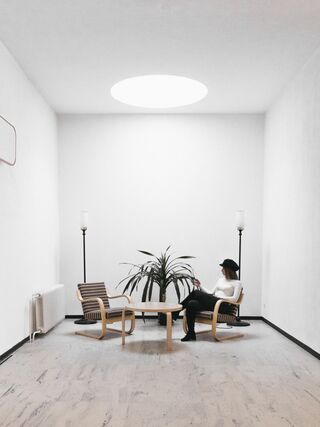Environment
The Comfort of the Physical Space of Therapy
Why a therapist's office looks the way it does.
Posted July 27, 2021 Reviewed by Abigail Fagan
Key points
- The seating in a therapist's office can vary depending on the type of therapy practiced.
- Extreme temperatures can affect how patients and therapists engage with the therapeutic process.
- Personal items, such as certificates and family photos, may influence how patients think about their therapist.
It is surprising how easily we can be affected by our surroundings. A hot summer's day can feel very different if we are experiencing it from a hot stuffy office than if we are in a beautiful garden.
Likewise, where we sit in relation to our therapist, the chairs and the room itself, even the environment external to the room, can all affect how we experience therapy.
For this reason, most therapists take great care to set up a therapeutic space that takes into account how their clients will be influenced by their surroundings. The seating in a therapeutic space is of great importance in therapy.

Therapeutic Seating
In some cases, seating can depend on the therapeutic discipline our therapist has chosen to train in. For example, a therapeutic couch is mainly used by psychoanalysts who work within a set of specific therapeutic principles that rely on revelations bubbling up from our subconscious mind, something called free association.
The reclining position of lying on the couch is said to help us relax enough to drift into a semi dream-like state without going to sleep. In this state of mind, we are better able to access deeper sensations and recall forgotten memories and emotions.
On the other hand, if our therapist is trained in emotionally focused therapy (EFT) they might be sitting in a chair with wheels, perhaps an office chair, which will help the therapist move closer or further away from us during therapy to help us experience and express our emotions.
Most therapists use chairs positioned more or less opposite each other with enough distance between them for us not to bash our feet together, though not so far apart that we need to shout to be heard.
This is so we can be face to face, creating a close, informal space where we can feel comfortable talking about ourselves. It might sound like the story of Goldilocks and the Three Bears, but, in this case, the size of the chairs matters too.
If the therapist has a bigger or higher chair than us, it can give the impression that they are of greater importance than us and we can easily begin to look to the therapist for answers or feel intimidated and be too willing to agree with them. We might even think of them as having a higher status, perhaps looking up to them not just physically, but psychologically too.
Therapy doesn’t aim to establish a hierarchical relationship between us and our therapist, which is why the therapist’s seating often is, if not the same as ours, at least at the same level as ours.
The Comfort of a Neutral Temperature
The room itself usually has the very basic of comforts too. It’s normally warm enough to be comfortable without being sleep-inducing. Extremes of temperatures will affect our ability to gain from our therapeutic interaction, perhaps distracting us from the conversation.
In one of the children’s centres where I worked with families, the heating was set to automatically turn off at 5 pm when the centre normally closed. During the winter months, by the time I saw my last clients at 8 pm, it would be cold enough for both my clients and me to keep our coats on.
Being this cold while doing therapy greatly affected our conversations: It wasn’t easy for my clients to focus on the depth of therapy while trying to keep warm and having our coats on made it feel as if we were finished before we started.
Items in a Therapist’s Room
To create a neutral environment where therapy is most at ease, the items on display in our therapist’s practice room will likely have a neutral meaning. We won’t find posters of political propaganda or personal photos on display. What we might see are therapy-related books and pictures with calming images.
Some therapists will have the tools of therapy on display, perhaps a bowl of stones or a basket of toy figures, maybe large sheets of paper and a jar of coloured pens.
Displaying Personal Items
There have been many debates about the appropriateness of displaying personal items such as thank-you cards or diplomas of qualification. Instead of entering therapy with a therapist who we can relate to as a neutral individual, seeing these personal items can encourage us to perceive different aspects of our therapist and that in turn can influence how we talk about our issues, which ultimately can affect the outcome of therapy.
Therapists in private practice often go to great lengths choosing their practice room and making sure the building itself is quiet with as few disruptions as possible. Where the building is situated is also important: too much noise from outside can be distracting to the therapeutic process.
A Noisy Experience
One of my practice rooms was situated in a building where family mediators and solicitors worked, which was perfect most of the time. However, the building was very close to a central hospital.
When choosing this room, I hadn’t taken into account the frequency of ambulance sirens leaving and arriving at the hospital. Most of my clients accepted this and, during deep therapeutic discussions, many barely noticed.
However, some found the sirens interfered with their chain of thought, but we usually learnt to work with this too.
The Calm Environment
Creating a calm environment doesn’t necessarily mean we, the client, have to be calm, but it does mean we have a peaceful and neutral environment to safely express our thoughts and emotions.
Because of the possible influence on their clients, the therapist will likely have put a lot of thought into providing a calm, quiet, neutral and comfortable space. Having therapeutic conversations in this environment will provide the best chances of achieving what we set out to achieve.
To find a therapist, visit the Psychology Today Therapy Directory.




